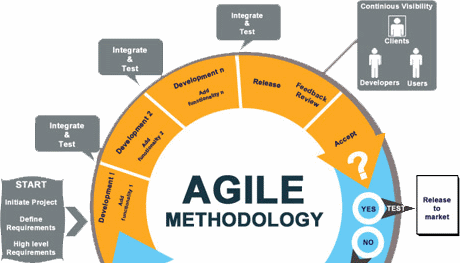Frequently asked questions about agile project management

What is agile?
Agile is a project management methodology that uses sprints (short cycles) to enable someone to focus on continuous improvement of a service or a product. Ideally, it reduces the complexity that many months-long cycles have, by breaking them down into the most crucial concepts to cash for the entire project.
The software developed this way delivers features with the highest value first and with exact information; the process allows to tightly manage time, cost and scope.
How old is Agile?
Although Agile is believed to have been in existence as far as in 1957, it was first discussed in depth by William Royce in the 1970s. He published a paper whereby he deeply discussed the issue of large-scale software development.
In 2001, the Agile Manifesto was published by 17 software developers. These developers came together and combined their experiences, and they were to come up with a lightweight development method. These are the 12 principles that still guide Agile project management today.
- The highest priority is customer satisfaction whereby this is to be achieved through rapid and continuous delivery.
- It embraces the change of environment at any stage of the process thereby giving the customer a competitive advantage.
- There should be close collaboration of stakeholders on a daily basis.
- There’s higher frequency of product or service delivery.
- Stakeholders and developers collaborate closely on a daily basis.
- Agile motivates all stakeholders and team members for an optional project outcome at all times.
- The most efficient and effective format for a successful project is through face-to-face meetings.
- The ultimate measure of success is determined by a final working product.
- Sustainable development is basically accomplished through the Agile process. It enables stakeholders and team members to maintain a constant ongoing phase.
- Simplicity is essential.
- Agile provides a continuous focus on project design and on technical excellence to enhance agility.
- Teams that are self-organized are highly expected to achieve the best and meet their requirements.
- Improved efficiency is required from teams, as well as using regular intervals and adopting a fine-tuning behavior.
Who uses Agile methodology?
It initially targeted the IT industry. Nowadays, many industries have fully adopted agile because of its effectiveness.
How do I use Agile?
The Agile methodology equips teams with an effective mechanism that detects and isolates problems to achieve specific goals quickly. It has helped because gone are the days when a large group of team members would wait for a lengthy, tiresome project phase to be completed, only to find that the concept and the customers’ expectations and needs have not been met.
Since it helps in breaking down long cycles into short ones, a large group of people is reduced to a small focused group. This enables them to discuss specific goals, and rapid effective change is made where required. It doesn’t require the entire group of team members to meet and discuss so as to make a change or to come up with a solution.
It equips teams with agility, they become more effective and chances of meeting customer’s goal become higher.
What are its advantages?
Agile has been widely adopted by different industries as the most effective project methodology, and it’s becoming extremely popular.
Since Agile basically reduces complexity, this methodology has many benefits including the following:
- It detects issues faster and isolates defects.
- It is very flexible and easily incorporates changes.
- It reduces workload by offering a more lightweight framework.
- It increases the chance of success.
- It minimizes resources hence reducing waste.
- It offers faster turnaround times.
What are the disadvantages?
As with any other methodologies, Agile has a few disadvantages:
- Agile software may not be suitable for all types of projects, hence due diligence is highly recommended when applying it.
- It is not an end-user option; it highly favors developers and project teams.
- Since agile is informal and flexible, it might not favor traditional organizations, or it may take long before they fully adopt it.
What are the popular agile methods used?
-
Scrum
The Scrum master method does not include a project manager. It guides the team and helps in prioritizing their tasks. It also helps in removing all impediments to implementing their tasks. Ideally, it exposes the organization’s impediments.
Although the Scrum master method is an entirely new to the world, it has been well adopted.
-
Kanban
This method that doesn’t require a lot of planning. It goes with issues that can’t be planned upfront. With Kanban, the issues are updated as soon they are completed. It suits projects where situations change on a daily basis.
-
Lean (LN)
Lean software development is based mostly on the notions of eliminating all unwanted waste that is of no value by focusing on concept to cash. It delivers high quality, fast.
The three methods are the most popular ones used in Agile. Much more exist and can be used according to the project in place. They include:
- Scrum-ban
- Rapid Application Development (RAD)
- Crystal
- Crystal Clear Method
- Extreme Programming (XP)
- Adaptive Software Development (ASD)
- Discipline Agile Delivery
- Agile Unified Process ( AUP)
Can Agile be combined with other methodologies?
Agile can be easily combined with other methodologies to increase chances of better results, or to get a perfect hybrid solution.
The combination helps to make the software development process more adaptable and to suit easily in various industries. However, due diligence is highly recommended to determine suitability and capacity of each method and the available processes.
What is the future of Agile?
Agile project management has been adopted by various industries. With many more industries coming up and businesses being set up, the chances of Agile to venture deeper remain high. Agile is here to stay because it is the best choice of most industries when it comes to cost, time and scope.
Do you have more questions about Agile project management?
Go to http://www.a1qa.com/blog/interview-with-lisa-crispin-whole-team-approach-to-quality/ and read the interview with Lisa Crispi, an agile testing practitioner and consultant.



